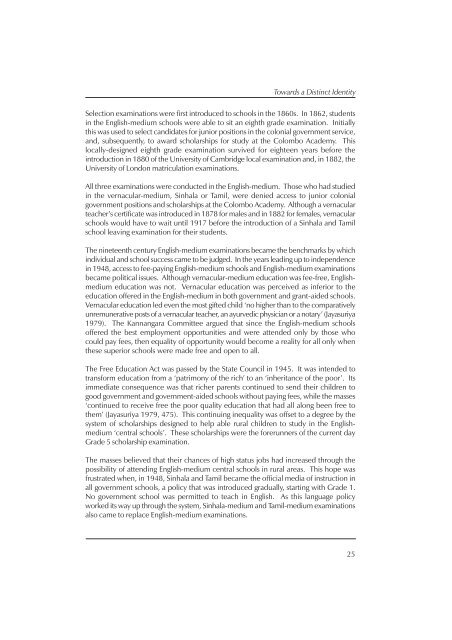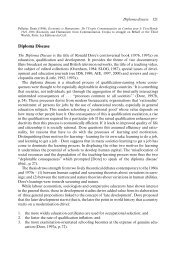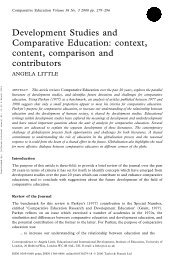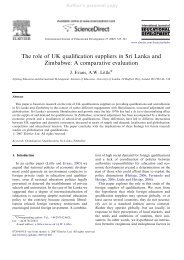Primary Education Reform in Sri Lanka - Angela Little's website
Primary Education Reform in Sri Lanka - Angela Little's website
Primary Education Reform in Sri Lanka - Angela Little's website
You also want an ePaper? Increase the reach of your titles
YUMPU automatically turns print PDFs into web optimized ePapers that Google loves.
Towards a Dist<strong>in</strong>ct Identity<br />
Selection exam<strong>in</strong>ations were first <strong>in</strong>troduced to schools <strong>in</strong> the 1860s. In 1862, students<br />
<strong>in</strong> the English-medium schools were able to sit an eighth grade exam<strong>in</strong>ation. Initially<br />
this was used to select candidates for junior positions <strong>in</strong> the colonial government service,<br />
and, subsequently, to award scholarships for study at the Colombo Academy. This<br />
locally-designed eighth grade exam<strong>in</strong>ation survived for eighteen years before the<br />
<strong>in</strong>troduction <strong>in</strong> 1880 of the University of Cambridge local exam<strong>in</strong>ation and, <strong>in</strong> 1882, the<br />
University of London matriculation exam<strong>in</strong>ations.<br />
All three exam<strong>in</strong>ations were conducted <strong>in</strong> the English-medium. Those who had studied<br />
<strong>in</strong> the vernacular-medium, S<strong>in</strong>hala or Tamil, were denied access to junior colonial<br />
government positions and scholarships at the Colombo Academy. Although a vernacular<br />
teacher’s certificate was <strong>in</strong>troduced <strong>in</strong> 1878 for males and <strong>in</strong> 1882 for females, vernacular<br />
schools would have to wait until 1917 before the <strong>in</strong>troduction of a S<strong>in</strong>hala and Tamil<br />
school leav<strong>in</strong>g exam<strong>in</strong>ation for their students.<br />
The n<strong>in</strong>eteenth century English-medium exam<strong>in</strong>ations became the benchmarks by which<br />
<strong>in</strong>dividual and school success came to be judged. In the years lead<strong>in</strong>g up to <strong>in</strong>dependence<br />
<strong>in</strong> 1948, access to fee-pay<strong>in</strong>g English-medium schools and English-medium exam<strong>in</strong>ations<br />
became political issues. Although vernacular-medium education was fee-free, Englishmedium<br />
education was not. Vernacular education was perceived as <strong>in</strong>ferior to the<br />
education offered <strong>in</strong> the English-medium <strong>in</strong> both government and grant-aided schools.<br />
Vernacular education led even the most gifted child ‘no higher than to the comparatively<br />
unremunerative posts of a vernacular teacher, an ayurvedic physician or a notary’ (Jayasuriya<br />
1979). The Kannangara Committee argued that s<strong>in</strong>ce the English-medium schools<br />
offered the best employment opportunities and were attended only by those who<br />
could pay fees, then equality of opportunity would become a reality for all only when<br />
these superior schools were made free and open to all.<br />
The Free <strong>Education</strong> Act was passed by the State Council <strong>in</strong> 1945. It was <strong>in</strong>tended to<br />
transform education from a ‘patrimony of the rich’ to an ‘<strong>in</strong>heritance of the poor’. Its<br />
immediate consequence was that richer parents cont<strong>in</strong>ued to send their children to<br />
good government and government-aided schools without pay<strong>in</strong>g fees, while the masses<br />
‘cont<strong>in</strong>ued to receive free the poor quality education that had all along been free to<br />
them’ (Jayasuriya 1979, 475). This cont<strong>in</strong>u<strong>in</strong>g <strong>in</strong>equality was offset to a degree by the<br />
system of scholarships designed to help able rural children to study <strong>in</strong> the Englishmedium<br />
‘central schools’. These scholarships were the forerunners of the current day<br />
Grade 5 scholarship exam<strong>in</strong>ation.<br />
The masses believed that their chances of high status jobs had <strong>in</strong>creased through the<br />
possibility of attend<strong>in</strong>g English-medium central schools <strong>in</strong> rural areas. This hope was<br />
frustrated when, <strong>in</strong> 1948, S<strong>in</strong>hala and Tamil became the official media of <strong>in</strong>struction <strong>in</strong><br />
all government schools, a policy that was <strong>in</strong>troduced gradually, start<strong>in</strong>g with Grade 1.<br />
No government school was permitted to teach <strong>in</strong> English. As this language policy<br />
worked its way up through the system, S<strong>in</strong>hala-medium and Tamil-medium exam<strong>in</strong>ations<br />
also came to replace English-medium exam<strong>in</strong>ations.<br />
25





